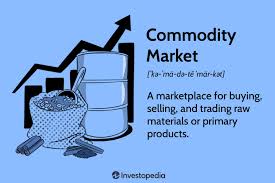How To Do Commodity Trading: A Beginner’s Guide
Commodity trading is one of the oldest and most dynamic forms of trading in the financial markets. It allows investors to buy and sell raw materials such as gold, silver, crude oil, natural gas, agricultural products, and more. If you are new to this investment avenue, understanding how to do commodity trading step by step will help you make informed decisions.
Commodity trading: what is it?
Buying and selling tangible items or their derivatives on specialized markets called commodity exchanges is known as commodity trading. For instance, in India, trading takes place on exchanges such as the National Commodity & Derivatives Exchange (NCDEX) and the Multi-Commodity Exchange (MCX). Platforms such as the London Metal Exchange (LME) and Chicago Mercantile Exchange (CME) are well-liked worldwide.
Commodity Types Traded
In general, commodities can be divided into four categories:
Metals: copper, aluminum, silver, and gold
Energy: Coal, Natural Gas, and Crude Oil
Agricultural: Cotton, Rice, Coffee, and Wheat
Meat & Livestock: Cattle, Bellies of Pork
How To Start Commodity Trading Step by Step
1. Learn the Basics
Before you start, familiarize yourself with commodity markets, trading terms, and how demand-supply factors affect prices.
2. Choose a Reliable Broker
Open a commodity trading account with a registered broker who is authorized by the exchange and SEBI (in India) or relevant regulators in your country.
3. Select the Right Exchange
Decide where you want to trade. For example, in India, you can trade on MCX or NCDEX, depending on the commodities you want to invest in.
4. Fund Your Trading Account
Deposit the required margin money. Commodity trading is often done through futures contracts, so a margin amount (a fraction of the total value) is required.
5. Research and Analysis
Use fundamental analysis (studying supply, demand, weather, geopolitics) and technical analysis (charts, indicators, trends) to identify good entry and exit points.
6. Place Your Trade
Decide whether to go long (buy) if you expect prices to rise or short (sell) if you expect them to fall.
7. Monitor and Manage Risks
Commodities can be highly volatile. Always use stop-loss orders to minimize risks and avoid over-leveraging.
8. Exit and Book Profits
Plan your exit strategy. Exiting at the right time is just as important as entering the trade.
Benefits of Commodity Trading
-
Portfolio diversification
-
Hedge against inflation
-
Potential for high returns
-
Exposure to global markets
Risks Involved
-
High volatility
-
Leverage risks
-
Dependence on external factors like weather, politics, and global demand
Tips for Successful Commodity Trading
-
Start small and gain experience before trading in large volumes
-
Stay updated with global market news and trends
-
Practice with demo accounts before real trading
-
Always trade with discipline and risk management in mind
